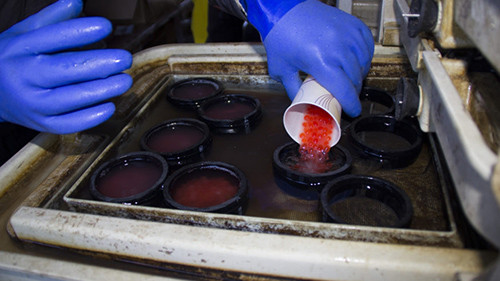By Lorraine Loomis, Chair, NWIFC
Despite their unbreakable connection, salmon harvest and habitat restoration continue moving down separate roads in western Washington. Many people either don’t see or choose to ignore the fact that habitat determines harvest, and that we continue to lose habitat faster than it can be restored.
Indian and non-Indian harvest has been cut to the bone this summer because of expected historically low returns, especially coho. Yet habitat loss and damage – the root of the problem – continues every day throughout our watersheds and nearshore marine waters.
Poor ocean survival conditions certainly played a role in the low salmon returns of the past several years. But even when we can restore or protect salmon habitat, we aren’t helping ourselves enough.
You might be surprised, but fish really do grow on trees. Trees keep water temperatures low, the way salmon like it. Their roots help to prevent soil erosion that can smother salmon eggs. When they fall into a river, trees provide diverse rearing habitat for fish. When the salmon spawn and die, their nutrients feed the trees.
Yet from 2006 to 2011 we lost the equivalent of two Seattle-sized forests or about 170 square miles, according to the treaty tribes’ 2016 State of Our Watersheds Report. The report can be viewed at nwifc.org/sow.
When we lose habitat, we also lose the natural production of salmon it provides. The collapse of our fisheries is simply mirroring the collapse of the eco-systems that support them.
For more than 100 years, hatcheries have tried to make up for that loss, but hatchery salmon depend on the same declining habitat as naturally spawning salmon.
About half of the salmon harvested in western Washington are hatchery fish. Continued habitat loss means we will have to depend on hatcheries for as long as lost and damaged habitat continues to restrict natural salmon production and threaten treaty rights.
Hatcheries are simply a tool. Some provide fish for harvest while reducing harvest pressures on weak stocks. Others serve as nurseries to protect threatened salmon stocks. All are essential to salmon recovery and should be integrated in our salmon recovery efforts for every watershed. We need every tool in the box to reinforce remaining salmon populations as we work to restore habitat.
The importance of this tool should be reflected in its funding, but as the need for hatchery fish has increased, state funding for hatcheries has declined or remained flat. Treaty tribes have stepped up to fill the gap in recent years and provide more salmon for everyone by picking up the costs at a number of state hatcheries where production was threatened by budget shortfalls.
The connection between harvest and habitat is clear. We cannot expect to harvest salmon – either hatchery or naturally spawning – as long as we continue to destroy salmon habitat. In the meantime, hatcheries must continue to help bridge that gap and be included as the essential part of salmon recovery that they are.
Lorraine Loomis is the chair of the Northwest Indian Fisheries Commission.

